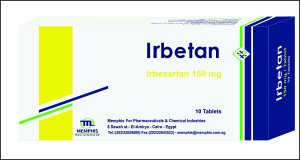TRADE NAME: IRBETAN 150 MG TABLETS. GENERIC NAME: Irbesartan COMPOSITION: Each tablet contains: Active ingredient: Irbesartan 150 mg : Excipients Microcrystalline cellulose, Lactose monohydrate, Pregelatinized starch, Colloidal silicon dioxide, Croscarmellose sodium, Polysorbate 80, Magnesium stearate . PHARMACEUTICAL FORM: Tablets. WARNING Do not use this product during pregnancy as it may harm or cause death to the fetus. PHARMACOLOGICAL ACTION: Pharmacotherapeutic group: Angiotensin-II antagonists. Mechanism of action: Irbesartan is a potent, orally active, selective angiotensin-II receptor (type AT1) antagonist. It is expected to block all actions of angiotensin-II mediated by the AT1 receptor, regardless of the source or route of synthesis of angiotensin-II. The selective antagonism of the angiotensin-II (AT1) receptors results in increases in plasma renin levels and angiotensin-II levels, and a decrease in plasma aldosterone concentration. Serum potassium levels are not significantly affected by irbesartan alone at the recommended doses. Irbesartan does not inhibit ACE (kininase-II), an enzyme which generates angiotensin-II and also degrades bradykinin into inactive metabolites. Irbesartan does not require metabolic activation for its activity. PHARMACOKINETICS: After oral administration, irbesartan is well absorbed: studies of absolute bioavailability gave values of approximately 60-80%. Concomitant food intake does not significantly influence the bioavailability of irbesartan. Plasma protein binding is approximately 96%, with negligible binding to cellular blood components. The volume of distribution is 53 - 93 litres. Following oral or intravenous administration of 14C irbesartan, 80-85% of the circulating plasma radioactivity is attributable to unchanged irbesartan. Irbesartan is metabolised by the liver via glucuronide conjugation and oxidation. The major circulating metabolite is irbesartan glucuronide (approximately 6%). In vitro studies indicate that irbesartan is primarily oxidised by the cytochrome P450 enzyme CYP2C9; isoenzyme CYP3A4 has negligible effect. INDICATIONS: Irbetan is indicated in adults for the treatment of essential hypertension. It is also indicated for the treatment of renal disease in adult patients with hypertension and type 2 diabetes mellitus as part of an antihypertensive medicinal product regimen. DOSAGE AND ADMINISTRATION: Posology The usual recommended initial and maintenance dose is 150 mg (one tablet) once daily, with or without food. Irbetan at a dose of 150 mg (one tablet) once daily generally provides a better 24 hour blood pressure control than 75 mg. However, initiation of therapy with 75 mg could be considered, particularly in haemodialysed patients and in the elderly over 75 years. In patients insufficiently controlled with 150 mg (one tablet) once daily, the dose of Irbetan can be increased to 300 mg (two tablets), or other antihypertensive agents can be added. In particular, the addition of a diuretic such as hydrochlorothiazide has been shown to have an additive effect with Irbetan . In hypertensive type 2 diabetic patients, therapy should be initiated at 150 mg irbesartan (one tablet) once daily and titrated up to 300 mg (two tablets) once daily as the preferred maintenance dose for treatment of renal disease.
